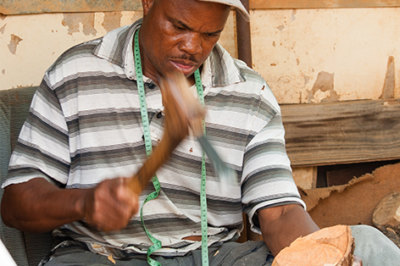Atelier MBOKA Fosters Artisan Comradery through Clustered Production Model

Adapted from an open submission by Tina Mbachu, Founder of Guild member business Atelier MBOKA, a Canadian-based enterprise working with artisans in eSwatini.
As the leader of a small artisan business, Atelier MBOKA, I face many challenges—from finding investors, to managing capacity and many other obstacles. One of the greatest challenges has been managing production from a distance. While I am headquartered in Canada, the skilled artisans we work with are based in Africa, which means we are an ocean and multiple time zones apart. This has forced us to be proactive and creative when it comes to problem solving.
Atelier MBOKA utilizes what we call a “clustered production model,” a system where we work with clusters of artisans in different locations. This model goes back to the making of our very first collection, a line of hand carved wooden handbags. When Atelier MBOKA was first established we worked with one senior wood carver in eSwatini who made beautiful hand carved pieces out of his home workshop. As the brand began to grow we realized no matter how talented this carver was, he could not single handedly produce the volume of product we needed. At the same time, we wanted to explore new technical approaches, specifically, we had started playing with designs for hand carved wooden handbags. We knew the craft traditions and the materials we wanted to use were in that specific region, and that this master carver could help train additional carvers. We were eventually introduced to a young carver and together we created our first series of hand carved hand bags which were launched at the Bushfire Festival, an international Swazi Arts and Music. This process laid the foundation for our “clustered production model,” a system we have been refining since. In addition to eSwatini, we now work with clusters of artisans in Tanzania and Zimbabwe.

Atelier MBOKA’s collection of wooden clutches made by carvers in eSwatini
From the making of this first collection we realized that training new artisan clusters in our techniques and designs was going to be the most challenging aspect to manage from overseas. This is particularly pronounced during the product sampling phase when we are trying out new designs and executions. In the sampling phase we often see discrepancies between the designs in our tech packs, a packet of technical drawings and instructions that demonstrate what the final product should look like, and the finished product. We quickly realized real-time communication and hands-on training were essential. In particular we found that having physical examples of a finished product went a long way in helping new trainees turn the two-dimensional drawings of the tech packs into beautiful finished pieces. To this aim, we began providing samples produced by other cluster groups who had mastered the given design. This allowed geographically separated artisans from different clusters, such as in Tanzania, Zimbabwe and eSwatini, to learn from one another through their crafts. It also introduced a healthy dose of competition! Soon, clusters were functioning as teams and working together to outperform other clusters, while individuals within the cluster pushed their personal creativity and technique mastery as they strove to be seen as leaders within the group.
This one creative solution was instrumental to the success of our “clustered production model,” and has transformed our approach to training and employee motivation.
Tags: Africa, Nest Guild